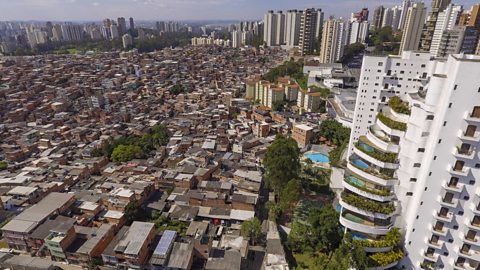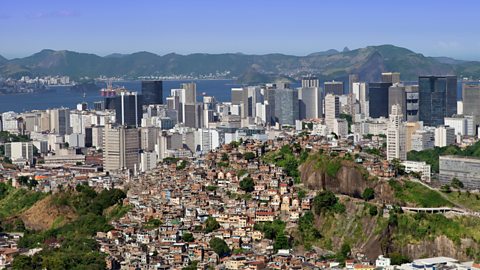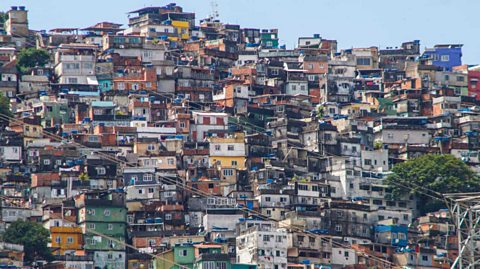Causes of urban growth
Although cities are growing urbanisationA growth in the urban population, usually resulting in the extension of towns or cities. in both MEDCMore Economically Developed Country вҖ“ usually a rich country found in Western Europe or North America. and LEDCLess Economically Developed Country вҖ“ usually a poorer country found in South America, Africa or Asia., the fastest-growing cities in the world are in LEDCs.
The reasons for the growth of urban areas in LEDCs include:
- A lack of employment opportunities in the countryside. Overpopulation and poor crop yieldThe amount of a crop harvested, usually represented as the mass from a certain area. are all push factorsNegative things that make people want to leave an area e.g war. which explain why people leave the countryside.
- Better paid jobs in the cities, an expected higher standard of living, and more reliable food are all pull factorsPositive aspects that attract people to move to a place e.g good job opportunities. which explain why people are attracted to the city.
- People who migrate to towns and cities tend to be young and so these locations have higher birth rates leading to higher growth.
- Better medical services in towns and cities compared to the countryside mean more successful births and a greaterlife expectancyThe average number of years a person is expected to live depending on where they live. in these areas.
There are many problems associated with the rapid growth. These include unplanned housing (squatter settlements/shanty townA shanty town, slum or favela is a name given to an illegal spontaneous settlement where people often have to live without basic services, such as water, sewage, electricity or waste collection.), dealing with urban waste, pollution and pressure on the city's services.

Land use in LEDCs
Although every LEDC city has its own characteristics, models can be used to illustrate a typical one.
- CBD: Offices, shops and traffic.
- Inner City: Expensive modern flats with modern amenities. Modern factories along main road.
- Suburban, high cost: High cost housing
- Permanent, low cost: Poor quality, but permanent housing. Small low cost government housing schemes.
- Temporary housing: Poor quality housing (slums and favelaA very poor quality house in Brazil (also called a slum).).
Both MEDC and LEDC cities have a CBD - often the oldest part of the city.
In LEDCs the poorest housing is found on the edge of the city - in contrast to MEDC cities whosesuburbsMainly a residential district near the outskirts of a city / town. They tend to be made up of lower density housing fringe is very often a place of high quality housing.
The areas of poor quality housing found on the edge of cities in LEDCs are called squatter settlements orshanty townA shanty town, slum or favela is a name given to an illegal spontaneous settlement where people often have to live without basic services, such as water, sewage, electricity or waste collection..
Characteristics of shanty town areas
- Overcrowding and poverty - the settlement has a high population density with the poorest residents of the city living in these informal settlements.
- Fires - fires can spread quickly.
- Overpopulation - the area does not have enough resources to support the growing population.
- Competition for jobs and employment - jobs are in short supply and shanty towns at the edge of settlements are often far away from employment opportunities in the city centres. Many are unemployed.
- Disease - poor sanitation and limited health care can lead to the spread of disease.
- Lack of space - the newest and poorest arrivals may be forced to live on the worst quality land.
- Infrastructure - services are poor, public transport is limited and connections to the electricity supply can be limited and sometimes dangerous.
Case study: Rio de Janeiro, Brazil

Rio de Janeiro is a city in south east Brazil.
An estimated 6.5 million people live in the city with around 22% of them residents of the city's favelas.
As migrants move into the city from rural areas they often live first in the informal favela areas where they build shelter and makeshift homes for themselves.
Most of the favelas are located on wasteland, marshy land, or land that is likely to flood.
They can also be found on very steep slopes where it would be impossible to build any other sort of building.
Favelas are often found on or near rubbish tips or along major transport links like railways and major roads.
In Rio de Janeiro, Rocinha is the largest favela in the city, and the second largest in Brazil. It is located on a hillside about one kilometre from the beach.
Rocinha
Some longer established favelas are closer to the centre, but still on land which most people would not build upon. One of the biggest favelas in the world, called Rocinha, is in Rio de Janeiro. Thought to be home to about 100,000 people, it is built on a steep hillside. Most buildings are now concrete and brick and almost all have basic plumbing and electricity, something more recently established shanty towns do not have. Rocinha still has a reputation for gang crime and drugs. There is widespread poverty and unemployment there.
Rocinha is one of the shanty towns in Brazil that have been changed by a Community Policing Programme called Pacifying Police Units (UPPs) introduced in 2008. This aimed to reduce gunfights in areas once controlled by drug gangs by permanently stationing police officers in the shanty town. The views of this initiative by those who live in favelas like Rocinha is mixed. While many were happy at first with the reduced violence and crime, there is increasing concern about corruption and police brutality.
The rapid growth of shanty towns

Hundreds of new migrants arrive into Rio de Janeiro each day.
Some of them come from abroad, especially from Portugal as Rio is the largest city of Portuguese speakers outside Portugal. There are also migrants from countries like South Korea and China, looking for business opportunities. These people will live in established housing areas of the city.
However, most of the migrants are poor people from the surrounding Brazilian countryside. These are the people who will have to use informal housing and this means that the favelas have been growing at a fast rate.
The population of Rio de Janeiro in 1950 was around 3 million. The whole metropolitan area had grown to 13.5 million by 2021.
The growth is largely because of migration, but there is also a lot of natural increaseNatural increase is the difference between the number of births and the number of deaths in a population. as there are so many young people in the city.
Reasons for migration to Rio de Janeiro
People were pulled into the city because they thought that Rio de Janeiro would provide better employment opportunities.
Rio de Janeiro has the second largest economy in Brazil and one of the fastest growing in the world.
Migrants were often pushed out of their areas towards Rio de Janeiro, especially from rural areas and small towns. Farming was difficult with very little pay for the effort involved. There were few opportunities.
Many rural areas struggled with either famine or drought so many farmers were keen to sell their farms and move into the big city to access better services and a better life for their families.
Newcomers to the city as it grew in the late 1800s did not have enough money to buy their own land and so were forced to live in squatter settlements. Many of these eventually developed into favelas, and people built temporary houses. Over time, temporary houses in some areas were improved. Most recent newcomers are forced to set up new informal housing at the edge of this enormous city.
Issues in Rio de Janeiro city
| Transport and Traffic | The number of cars in Rio has increased enormously resulting in heavy traffic which creates a lot of noise and pollution. The public transport system was struggling to cope with the huge numbers of people in the city. While Rio has invested strongly in public transport recently and encouraged bike travel, congestion and pollution is still an issue. |
| Segregation | There is very little social interaction between the social classes and many of the rich people feel threatened by those who live in the favelas. |
| Services | Most favelas have limited access to clean drinking water, electricity, toilets, schools or good quality healthcare. There are few refuse collections and sewage is not collected centrally and often will contaminate drinking water supplies. Disease is widespread. In a few favelas local people have developed services to support their communities. |
| Employment | People who live in the favela find it extremely difficult to get a good education and then to get a good formal job. Instead, most are forced to work in the informal sector - working on the rubbish tips or selling fruit. Some may turn to crime or prostitution. |
| Housing | Favela houses are built using whatever materials that can be found вҖ“ usually on a temporary basis. Houses can be destroyed by accidental fire or through slum clearance by the local government. Because the favelas are built on land that cannot otherwise be used, there are many examples of rich areas with expensive flats or houses built next door to a favela. |
| Crime | Crime, violence, murder, prostitution and drug trafficking are all major issues in many favelas. Often this is the only way that some people believe they can survive. |
| Pollution | Like any settlement, a favela produces large amounts of waste. However, in the favela this is usually not managed in an efficient manner. There are huge numbers of health hazards across the city but these are much worse in the favelas. |
Activity: Take the test
More on Changing urban areas
Find out more by working through a topic
- count1 of 4

- count3 of 4
